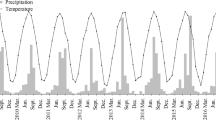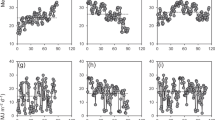Abstract
Crop production depends on the interaction of climatic factors and agricultural management, such as nitrogen (N) fertilizer input in agricultural ecosystems. Understanding crop yield responses to climatic factors and N fertilizer supply can help select appropriate cultivars and develop appropriate measures to achieve the high and stable crop yield. In this study, a long-term N fertilizer experiment was conducted consisting of two crops (winter wheat and summer maize) from 1992 to 2014, to investigate the crop yield response to climatic factors and N treatments in Hotan, Xinjiang Uygur autonomous region. A long-term N supplied and without N supplied treatments significantly affect the soil properties and crop yields. It was found that low N stress significantly reduced the grain yield ranged from 33.1 to 76.4% and 26.8 to 69.3% for winter wheat and summer maize respectively. The grain N concentration was significantly reduced with the increase in N stress. There was positive correlation between crop yield and accumulated temperature (R2 = 0.58, P < 0.001) under high N conditions, and negative correlation (R2 = 0.50, P < 0.001) under low N conditions. Our result shows that the accumulated temperature is gradually increasing from 4051 to 5218 °C year−1 in the past 23 years (1992–2014) in Xinjiang Uygur autonomous region. Under sufficient N supplied conditions, the increase of accumulated temperature positively promote crop yields. However, under N deficient conditions, increasing accumulated temperature will further exacerbate the N stress effect and reduce crop yields. Hence, we recommended sufficient N fertilizer input in Hotan, Xinjiang region, which can maintain higher crop yield.



Similar content being viewed by others
Availability of Data and Material
Data are available from the corresponding author on reasonable request.
References
Abe, A., Menkir, A., Moose, S. P., Adetimirin, V. O., & Olaniyan, A. B. (2013). Genetic variation for nitrogen-use efficiency among selected tropical maize hybrids differing in grain yield potential. Journal of Crop Improvement, 27(1), 31–52. https://doi.org/10.1080/15427528.2012.721483.
Bernard, H., Mark, R., Martinus, A. J. S. V. B., & Rodomiro, O. (2010). The future of food: Scenarios for 2050. Crop Science, 50, S33–S50.
Bremner, J. M. (1996). Nitrogen-Total. In D. Sparks, A. Page, P. Helmke, R. Loeppert, P. N. Soltanpour, M. A. Tabatabai, et al. (Eds.), Methods of soil analysis (pp. 1085–1121). Madison, USA: ASA.
Chen, X., Chen, F., Chen, Y., Gao, Q., Yang, X., Yuan, L., et al. (2013). Modern maize hybrids in Northeast China exhibit increased yield potential and resource use efficiency despite adverse climate change. Global Change Biology, 19(3), 923–936. https://doi.org/10.1111/gcb.12093.
Chen, Y., Xiao, C., Chen, X., Li, Q., Zhang, J., Chen, F., et al. (2014). Characterization of the plant traits contributed to high grain yield and high grain nitrogen concentration in maize. Field Crops Research, 159, 1–9. https://doi.org/10.1016/j.fcr.2014.01.002.
Chi, Y., Xu, M., Shen, R., Yang, Q., Huang, B., & Wan, S. (2013). Acclimation of foliar respiration and photosynthesis in response to experimental warming in a temperate steppe in northern China. PLoS One, 8(2), e56482–e56482. https://doi.org/10.1371/journal.pone.0056482.
Davidson, E. A. (2009). The contribution of manure and fertilizer nitrogen to atmospheric nitrous oxide since 1860. Nature Geoscience, 2, 659–662. https://doi.org/10.1038/ngeo608.
Gaju, O., Allard, V., Martre, P., Le Gouis, J., Moreau, D., Bogard, M., et al. (2014). Nitrogen partitioning and remobilization in relation to leaf senescence, grain yield and grain nitrogen concentration in wheat cultivars. Field Crops Research, 155, 213–223. https://doi.org/10.1016/j.fcr.2013.09.003.
Gao, C., Kim, Y., Zheng, Y., Yang, W., Chen, L., Ji, N., et al. (2016). Increased precipitation, rather than warming, exerts a strong influence on arbuscular mycorrhizal fungal community in a semiarid steppe ecosystem. Botany, 94(6), 459–469. https://doi.org/10.1139/cjb-2015-0210.
Harms, T. E., & Konschuh, M. N. (2010). Water savings in irrigated potato production by varying hill–furrow or bed–furrow configuration. Agricultural Water Management, 97(9), 1399–1404. https://doi.org/10.1016/j.agwat.2010.04.007.
Hou, P., Liu, Y., Xie, R., Ming, B., Ma, D., Li, S., et al. (2014). Temporal and spatial variation in accumulated temperature requirements of maize. Field Crops Research, 158, 55–64. https://doi.org/10.1016/j.fcr.2013.12.021.
Intergovernmental Panel on Climate Change. (2000). Special Report on Emissions Scenarios, Summary for Policy Makers, Working Group III, International Panel on Climate Change. Cambridge, UK: Cambridge Univ Press.
Jiao, X., Mongol, N., & Zhang, F. (2018). The transformation of agriculture in China: Looking back and looking forward. Journal of Integrative Agriculture, 17(4), 755–764. https://doi.org/10.1016/S2095-3119(17)61774-X.
Kilpeläinen, A., Gregow, H., Strandman, H., Kellomäki, S., Venäläinen, A., & Peltola, H. (2010). Impacts of climate change on the risk of snow-induced forest damage in Finland. Climatic Change, 99(1), 193–209. https://doi.org/10.1007/s10584-009-9655-6.
Liu, Z., Zhao, Y., Guo, S., Cheng, S., Guan, Y., Cai, H., et al. (2019). Enhanced crown root number and length confers potential for yield improvement and fertilizer reduction in nitrogen-efficient maize cultivars. Field Crops Research, 241, 107562. https://doi.org/10.1016/j.fcr.2019.107562.
Márton, L. (2007). Long term studies of crop yields with changing rainfall and fertilization. Agricultural Engineering Research, 13(3), 37–47. https://doi.org/10.1556/crc.36.2008.3.15.
Miao, Y., Stewart, B. A., & Zhang, F. (2011). Long-term experiments for sustainable nutrient management in China. A review. Agronomy for Sustainable Development, 31(2), 397–414. https://doi.org/10.1051/agro/2010034.
Olsen, S. R., Cole, C. V., Watanabe, F. S., & Dean, L. A. (1954). Estimation of available phosphorus in soils by extraction with sodium bicarbonate. U.S. Department Agriculture Circular (pp. 939–1019).
Pan, G., Gao, M., Hu, G. H., Wei, Q. P., Yang, X. G., Zhang, W. Z., et al. (2011). Impacts of climate change on agricultural production of China. Journal of Agro-Environment Science, 30, 1698–1706.
Peng, J. (2018). Climate-growth response of Chinese white pine (Pinus armandii) at different age groups in the Baiyunshan National Nature Reserve, central China. Dendrochronologia, 49, 102–109. https://doi.org/10.1016/j.dendro.2018.02.004.
Peng, S., Cassman, K., Virmani, S. S., Sheehy, J., & Khush, G. (1999). Yield potential trends of tropical rice since the release of IR8 and the challenge of increasing rice yield potential. Crop Science, 39, 1552–1559.
Rockström, J., Karlberg, L., Wani, S. P., Barron, J., Hatibu, N., Oweis, T., et al. (2010). Managing water in rainfed agriculture—The need for a paradigm shift. Agricultural Water Management, 97(4), 543–550. https://doi.org/10.1016/j.agwat.2009.09.009.
Rodrigues, M., Rezende, W., Silva, M., Faria, S., Zuffo, L., GalvÃ, J., et al. (2017). Genotypic variation and relationships among nitrogen-use efficiency and agronomic traits in tropical maize inbred lines. Genetics and Molecular Research, 16(3), gmr16039757.
Schmidhuber, J., & Tubiello, F. N. (2007). Global food security under climate change. Proceedings of the National Academy of Sciences, 104(50), 19703–19708. https://doi.org/10.1073/pnas.0701976104.
Shi, W., Tao, F., Liu, J., Xu, X., Kuang, W., Dong, J., et al. (2014). Has climate change driven spatio-temporal changes of cropland in northern China since the 1970s? Climatic Change, 124(1), 163–177. https://doi.org/10.1007/s10584-014-1088-1.
Song, B., Niu, S., & Wan, S. (2016). Precipitation regulates plant gas exchange and its long-term response to climate change in a temperate grassland. Journal of Plant Ecology, 9(5), 531–541. https://doi.org/10.1093/jpe/rtw010.
Walkley, A. (1947). A critical examination of a rapid method for determining organic carbon in soils—Effect of variations in digestion conditions and of inorganic soil constituents. Soil Science, 63(4), 251–264.
Wan, S., Zhang, C., Chen, Y., Zhao, J., Zhu, X., Wu, J., et al. (2014). Interactive effects of understory removal and fertilization on soil respiration in subtropical Eucalyptus plantations. Journal of Plant Ecology, 8(3), 284–290. https://doi.org/10.1093/jpe/rtu013.
Wheeler, T. R., Batts, G. R., Ellis, R. H., Hadley, P., & Morison, J. I. L. (1996). Growth and yield of winter wheat (Triticum aestivum) crops in response to CO2 and temperature. The Journal of Agricultural Science, 127(1), 37–48. https://doi.org/10.1017/S0021859600077352.
Wheeler, T., Chatzialioglou, A., Craufurd, P., Ellis, R., & Summerfield, R. (1997). Dry matter partitioning in groundnut exposed to high temperature stress. Crop Science, 37(5), 1507–1513.
Wu, Y., Ma, Z., Wang, D., & Jiang, J. (1998). Analyses of contribution of maize improvement to yield increment in China. Acta Agronomica Sinica, 24, 595–600.
Xia, J., & Wan, S. (2013). Independent effects of warming and nitrogen addition on plant phenology in the Inner Mongolian steppe. Annals of Botany, 111(6), 1207–1217.
Xie, J., Chen, J., Sun, G., Chu, H., Noormets, A., Ouyang, Z., et al. (2014). Long-term variability and environmental control of the carbon cycle in an oak-dominated temperate forest. Forest Ecology and Management, 313, 319–328.
Xu, M., & Li, Z. (2016). Accumulated temperature changes in desert region and surrounding area during 1960–2013: A case study in the Alxa Plateau, Northwest China. Environmental Earth Sciences, 75(18), 1276. https://doi.org/10.1007/s12665-016-6084-5.
Yu, Q., Li, L., Luo, Q., Eamus, D., Xu, S., Chen, C., et al. (2014). Year patterns of climate impact on wheat yields. International Journal of Climatology, 34(2), 518–528.
Yue, T., Zhao, N., Ramsey, R. D., Wang, C., Fan, Z., Chen, C., et al. (2013). Climate change trend in China, with improved accuracy. Climatic Change, 120(1–2), 137–151.
Zhang, J. (2011). China’s success in increasing per capita food production. Journal of Experimental Botany, 62(11), 3707–3711. https://doi.org/10.1093/jxb/err132.
Zhang, X. Q., Sun, Y., Mao, W. F., Liu, Y. Y., & Ren, Y. (2010). Regional response of temperature change in the arid regions of China to global warming. Arid Zone Research, 27, 592–599.
Zhao, B., Li, X., Li, X., Shi, X., Huang, S., Wang, B., et al. (2010). Long-term fertilizer experiment network in China: Crop yields and soil nutrient trends. Agronomy Journal. https://doi.org/10.2134/agronj2009.0182.
Zhou, H., Xu, M., Hou, R., Zheng, Y., Chi, Y., & Ouyang, Z. (2018). Thermal acclimation of photosynthesis to experimental warming is season-dependent for winter wheat (Triticum aestivum L.). Environmental and Experimental Botany, 150, 249–259.
Acknowledgements
We thank all those who helped with sample collection and processing of this study. We sincerely thank the reviewers for their helpful comments. We thank Mr Olukayode, Toluwase for editing the English text of a draft of this manuscript.
Funding
This work was supported by the National Key Research and Development Program of China, Grant No. 2018YFD0200406, and by the National Natural Science Foundation of China, Grant No. 41261075, 41461047.
Author information
Authors and Affiliations
Contributions
SC and QG conceived of and designed the study. QG and QL analyzed the data and wrote the manuscript. QG, AA, and NL carried out the field measurements and soil analysis. SC assisted with manuscript writing and editing. All authors approved the final version of the manuscript.
Corresponding author
Ethics declarations
Conflict of Interest
The authors declare no potential conflict of interest for this research.
Code Availability
Not including custom code during the current study.
Electronic supplementary material
Below is the link to the electronic supplementary material.
Rights and permissions
About this article
Cite this article
Geng, Q., Aizizi, A., Lai, N. et al. Impact of Climatic Factors and Nitrogen Levels Drivers on Crop Yield in the Arid Region of China. Int. J. Plant Prod. 14, 635–645 (2020). https://doi.org/10.1007/s42106-020-00107-3
Received:
Accepted:
Published:
Issue Date:
DOI: https://doi.org/10.1007/s42106-020-00107-3




